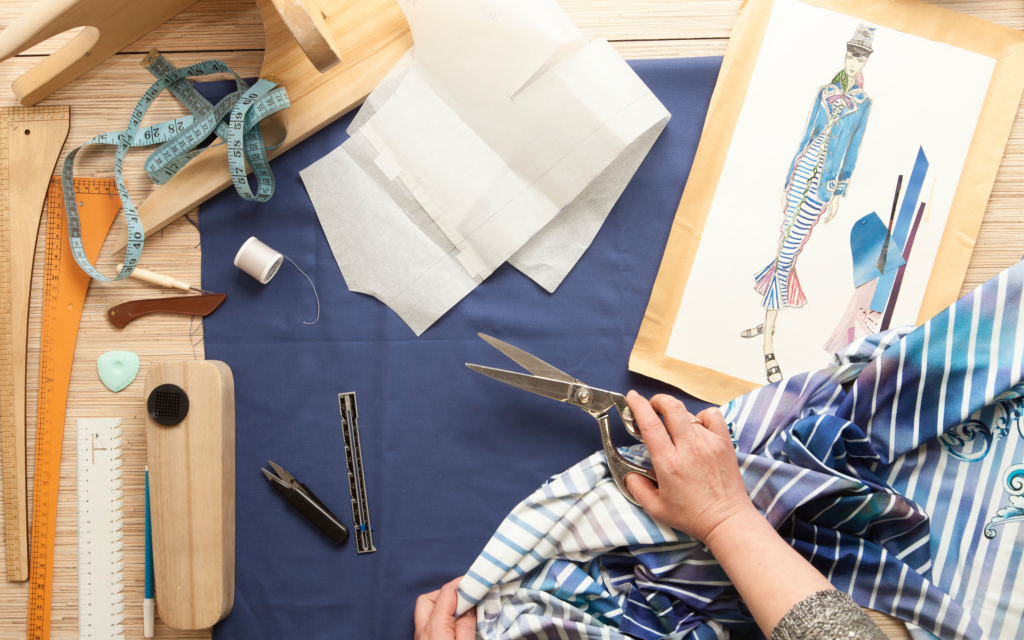A skilled tailor with a passion for fashion and an entrepreneurial personality, are you? This could be the ideal opportunity to transform your talent into a successful enterprise by How to start a tailoring business at home. In today’s society, where personalized services are highly valued, a home-based tailoring business can provide a distinctive and rewarding experience for both you and your clients.
The craft of a successful tailoring business demands an in-depth awareness of design and fabrics, as well as perfection and creativity. Reducing the expenses associated with renting a commercial space is possible by conducting business from one’s home, which enables one to sustain reasonable rates while enhancing profits.
Furthermore, the convenience of a home-based business allows for the establishment of a personalized schedule, which promotes a harmonious work-life equilibrium.
We usually see our mothers and aunties stitching at home, but have you ever advised them to sell it? We suppose not. Let’s help them establish a business now. We will cover all you need to know to start a tailoring business at home. Read on to learn how to turn your home into a company.
In this blog, we’ll explore the essential steps to kickstart your tailoring business from home, ensuring a solid foundation for growth and success.
What is a tailoring business?

Any store or service that offers personalized garment repair and customization is known as a tailoring business. Tailors are master artisans who can do anything from mending pants to taking in a shirt to making a custom suit from the ground up, ensuring that the finished product fits like a glove.
To provide their customers with the best possible fit and style, these experts use a wide variety of fabrics, sewing machines, and other instruments. While some tailors focus on making bridal dresses or suits for men, others are more generalists who can fix almost anything.
In general, if you want your clothing to fit perfectly and feel great, according to your exact measurements and personal tastes, a tailor can help you reach your goal.
The market opportunity for starting a tailoring shop
The growing demand for custom-made clothing presents a profitable market opportunity for the starting of a tailoring business. Currently, multiple individuals are choosing to prioritize different and personalized garments over mass-produced clothing.
This trend is particularly apparent in the casual wear sector, where people are seeking versatile items that are both comfortable and reflective of their unique style. A tailoring business can serve this expanding market by providing services for items such as festive seasons, loungewear, t-shirts, and jeans.
During the festival season, a saree and a designer blouse are the preferred attire for many women. In addition to purchasing a saree, they require a blouse. Typically, a bodice is included with the saree. Once more, they require a skilled tailor who can create a garment that is both custom-designed and custom-fitted. To prevent the yarns from fraying, they must affix the fall to the saree and complete both ends of the saree.
People are moving to flats in societies in metros and big towns these days. Being in such a big city with so many families is enough to start a sewing shop business.
For housewives and other women who are interested in earning money while also taking care of their family members, the tailoring business is an excellent option.
Knowledge and skill requirements for tailoring business

- Skill in both machine and hand stitching methods.
- Understanding of pattern creation and clothing adjustments.
- Understanding of the many kinds of fabrics, their properties, and their maintenance needs.
- Accurately measuring the body and fitting clothes to various body types.
- Knowing about and being able to use fashion trends into designs.
- Great care to guarantee excellent finishing and stitching.
- Competencies in time management to manage several projects and meet deadlines.
- Excellent customer service and knowledge of client needs are made possible by strong communication abilities.
- Understanding of basic business administration, including pricing and budgeting.
- Technical ability with different tailoring tools and equipment as well as sewing machines.
Equipment needed for a tailoring business

A tailoring establishment needs at least one blackhead single needle lock stitch machine and one three-thread overlock machine. Edge finishing is done with an interlocking machine. You can also buy industrial sewing machines. Amazon sells black-head sewing machines for 3500–6000 rupees. (Amazon Source Link)
Pattern making, garment measuring, and textile cutting require a table. A 6′ x 4′ tabletop works. A 4 x 3.5-square-foot table works for tiny spaces.
- Sewing machine (with various stitch options)
- Serger (overlock machine) for seam finishing
- Iron and ironing board
- Cutting table
- Dress form or mannequin
- Buttonhole machine (optional, for increased efficiency)
- Blind hemming machine (optional, for precise hemming)
- Embroidery machine (optional, for embellishments)
- Fabric cutting tools (scissors, rotary cutter, cutting mat)
- Pressing tools (steam iron, pressing cloth)
What are the different types of tailoring business?
Custom Tailoring: Providing clothing that is made to measure according to the exact requirements and measurements of each customer is what custom tailoring entails.
Alterations and Repairs: A specialty that focuses on modifying existing garments to create a better fit or repairing garments that have been damaged by wear and tear.
Bespoke Tailoring: Crafting high-end, custom-made garments from scratch, more often than not utilizing premium fabrics, and responding to specific client requirements is what is meant by the term “bespoke tailoring.”
Specialty Tailoring: Focusing on a certain segment of the market, such as bridal clothing, formal dress, or costumes, and providing specialized services that are tailored to that segment of the market is an example of specialty tailoring.
Online Tailoring: Online Tailoring is a business model that predominantly operates through an online platform, providing virtual consultations, measurement instructions, and shipping services for clothing that are tailored to client specifications.
Fashion Tailoring: Tailoring in the fashion industry refers to the process of working together with fashion designers or brands to create bespoke clothing lines or collections, typically for commercial purposes such as photo sessions, retail sales, or runway displays.
Corporate Tailoring: Corporate tailoring refers to the process of providing firms, organizations, or institutions with specifically tailored uniforms or corporate apparel, which frequently includes the embroidery or customization of their emblem.
Mobile Tailoring: Mobile tailoring refers to the provision of tailored services on-site, which can be accomplished through the use of a mobile studio or by traveling to the client’s homes or places of business to perform changes and fittings.
How to start a tailoring business at home
Now, after discussing its breadth, profit, and types. Now is the moment to launch this business. If you’re reading this blog then surely you would like to start a tailoring business. These are the steps to start this business:
1. Hone Your Skills:
Consider devoting some of your time to perfecting your tailoring techniques. Attend workshops, enroll in classes, or seek mentorship from expert tailors to improve your tailoring skills. To differentiate yourself in a highly competitive business, you should become proficient in the art of pattern drafting, fabric manipulation, and delicate sewing.
If you choose something you are unfamiliar with yet want to do, you should seek training. Taking training will assist you learn the fundamentals that you can apply to generate good work. On the other hand, if you are employing people to work for you, you should provide them with basic training on how everything works.
2. Establish a Dedicated Workspace: Your Home
Knowing that you will launch your business from home, you now need to be certain about the location of your home office. You cannot simply work anywhere and leave your house untidy. Selecting a location and working there with your team are necessary.
The location may be a room outside of your house, any space inside, or both. Anything can be it as long as you are working in the appropriate atmosphere. Therefore, consider where to locate your tailoring business before you launch it.
3. Acquire Essential Supplies:
Make sure you have a sufficient supply of high-quality notions, including fabrics, threads, buttons, and zippers. When you have a diversified inventory, you will be able to satisfy the tastes of a wide range of customers and the requirements of a variety of projects.
- The first and the most important is a sewing machine
- Scissors for cutting
- Scales and measuring tape
- Chalk for drafting
- Needles and threads
- Hangers and stands
- Electric iron
- Table
- Short shelves for storing the cuttings
- Embroidery tools
4. Develop a Business Plan:
Make sure to create a detailed business plan that includes a description of your target market, pricing methods, marketing approaches, and financial estimates. Your path to achievement will be mapped out for you by this plan.
For example, the marketing phase will begin once you have everything in place and are operating your company at a steady rate. One of the most crucial aspects of any business is marketing; if you do not engage in marketing, your company will continue to be average and will not develop into something amazing. In addition, I believe that nobody wants to be ordinary; everyone strives to be more than average.
If you want your company to be seen by virtually everyone, then you will need to put in additional effort in the form of marketing. You are going to have to concentrate on marketing.
Also, You know finance management is exhausting. When running or starting a business, finance management is crucial. Every business expense must be managed by you.
Additionally, investing in your business is a major financial choice. You must evaluate all considerations while deciding how much to invest. Although this business doesn’t demand much money, it must be decided beforehand.
If you don’t decide, you can’t handle finances later. If you don’t have enough money for your business, you must borrow. You must determine who to borrow from when you borrow. So it’s lengthy. Managers must be ready or can be assisted.
5. Register the business
No business may be unregistered and successful. Because unregistered businesses confront many unforeseeable challenges. Anyone liable for your business must register it under valid acts.
If your firm is a corporation, it must be registered under the Companies Act. You can hire a business registration expert. Your business will appear on invoices if registered.
6. Need workers? Hire them.
After starting a successful small business marketing , this step may happen. You need someone to help you meet deadlines when you have several job orders. As you cannot risk delaying any customer’s work at that point. He will not return if you do.
So, you’ll need a few hires to keep your customers. However, after hiring, you must ensure their work matches yours. You and the customer will lose money if the consumer is unhappy. Thus, train them by communicating your expectations.
7. Open your Online store
One way to expand your business is to open an online store. You are aware of the current number of customers who utilize the Internet. Therefore, if you open an online store, you should aim to attract a big audience. It will help your business reach new heights of growth. You’ll also attract a substantial number of customers.
Benefits of starting a tailoring business at home

1. Job independence:
The business lets you deal with fashion concepts and consumer needs. Any men’s or women’s tailoring is possible depending on your expertise.
You can choose from standard cloth stitching, suit specialists, pattern making, sample making, cross-stitching, hemming, pet-wear designing, uniform designing, costume designing, uniform designing, curtains, bags, and more.
2. Sewing Instructor:
Many people want to learn sewing from an expert. They wish to learn from a tailor with extensive knowledge of most related fields. Your expertise can instruct learners nationwide.
Your training programs can be advertised in newspapers, pamphlets, banners, the internet, and other media.
3. Less Investment:
Investment is the biggest reason people don’t start enterprises. Investment is low here, so you don’t have to worry. The key reason for less investment is that you can start your business at home without spending anything.
You just need your sewing machine, space, and other supplies. That’s the benefit of a tailoring business from home.
4. High profit margins:
When you don’t spend much, all your money goes into profit. You can make money by employing different designs, improving your talents, providing excellent customer service, offering discounts, etc. Profit may vary according to the orders you obtain, such as uniform or bridal dress sewing. Profit margin increases with order size.
5. Online Stor Opening Option:
After launching your business, you can open an internet store if you’re doing well. It will boost your brand and business reach. Your services can be ordered by others. It will make you famous.
Rate of common boutique work in India
When we examine the compensation statistics of Boutiques in India as of the 29th of May in the year 2024, we find that the employee who is being represented earns ₹15,21,738. To provide a more accurate estimate, the pay rate is ₹1,26,811 per month, ₹29,264 per week, or ₹707.46 per hour.
The average salary of a tailor
The average monthly compensation for a tailor is ₹18,000+ They may earn more depending on region, experience, and company. Experience can boost tailors’ pay. They may receive vacation and other benefits in addition to wages. Independent tailors run their enterprises.
Conclusion
All things considered, anyone with sewing abilities and an entrepreneurial spirit can start a tailoring business this blog is on “How to start a tailoring business at home. The important actions are getting the required licenses and permits, establishing a specific workplace, making quality equipment and supply investments, creating a compelling portfolio, creating an internet presence, and putting into practice successful marketing plans.
A competitive advantage can also come from concentrating on a certain area, providing customized services, and always honing your abilities. Your love of tailoring can become a profitable home-based business with a devotion to client satisfaction, hard work, and perseverance.
FAQs
A business plan should be prepared, the market need should be investigated, a designated workspace should be established, the necessary equipment should be purchased, and any relevant licenses or permits should be obtained.
A: Take into account elements like the cost of materials, the amount of time needed for each project, the level of experience, and local market rates when determining pricing. Setting competitive prices can also be aided by performing a competitive analysis.
A sewing machine, cutting tools, measuring tape, threads, needles, pins, iron, and a designated workplace with enough lighting and ventilation are examples of essential tools and equipment.
A decent website , landing page or social media presence, special discounts, networking with nearby companies, and using images or client testimonials to highlight your work are some ways to draw in clients. You can try AI landing page builders for this work.
A: While official training or certification is not required, taking classes or completing an apprenticeship can help you gain the necessary information and abilities to improve your credibility and level of experience in the subject.



